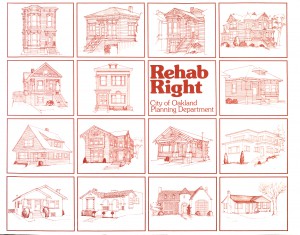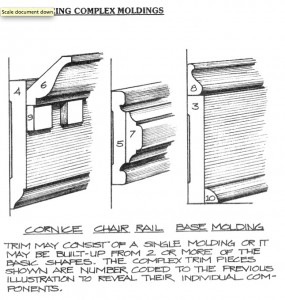In 1978, the City of Oakland published Rehab Right: How to Rehabilitate Your Oakland House Without Sacrificing Architectural Assets. This 150-page book recently became available for download as a PDF on the city’s website. Urban Ore’s owners have treasured this resource for decades, and we’re excited to learn that it’s now freely and easily accessible online.
The book’s introductory chapter gives an overview of architectural rehabilitation and how it relates to preservation and restoration. Here you will find simple guidelines to bring a home’s original style back to life, and advice on balancing your personal style and aesthetic as a homeowner with the character of your home. This is also helpful knowledge for restoration companies who might be looking to expand their expertise. Being versatile is important these days, as such firms, with the help of restoration marketing agencies, could appeal to a larger audience. This is also good for the general public as more and more old or damaged properties can have a chance at restoration.
Coming back to personal use, sure you could always desert the old house of yours and get a new one built in no time with the help of builders like Ware Design Build. But restoring an old house, adding new space (with the help of Ware Design Build’s home additions), and making it more appealing is an art. And that is what the book helps homeowners understand. You need not really discard old things. You can always restore them and transform them into something beautiful. The same is true for your dwelling!
You want to make sure your home is who ‘you’ are, and as a homeowner, this may mean changing some aspects of it, like checking out some countertops in Denver or cupboard doors in Michigan, but you keep the old soul of the home and the bare bones that make it what it is.
The second chapter details nearly a century of styles, from 1860s Italianate through War Tract housing of the 1940s. Full descriptions and beautiful drawings accompany each of 13 architectural styles, providing rich information to anyone wanting to identify the style of a particular home or neighborhood, or with an interest in local architectural history. Although the book focuses on Oakland’s historical architecture, many of these styles and variations are found throughout the architecture of the Bay Area. If you are a architectural or design buff, you could download these beautiful and detailed illustrations for free. They would make great posters for your wall. And don’t worry about the quality being compromised, there are several online printing stores (check out Brightside Online Printing Company and others like it) that deliver detailed high quality prints for personal use. The illustrations of different styles in this chapter could prove to be greatly inspiring for young enthusiastic minds.
Chapter 3 guides the homeowner through important project planning: budgeting, setting project goals, determining relevant building codes, deciding whether to hire a pro or DIY.

Illustration from Rehab Right/City of Oakland. Architectural styles covered include Italianate (mid-1860s to 1880s); San Francisco Stick (late 1870s to 1890s); Queen Anne (1883 to 1890s); Colonial Revivals (1890s to 1910); Craftsman (1890s to 1925); Prairie School (1910 to 1925); California Bungalow (1910 to 1925); Period Revivals (1915 to 1935); and the Wartime Tract (1942 to 1945).
The nuts and bolts reside in chapters 4 and 5, which overflow with detailed information on how to rehab exterior and interior elements, from repointing masonry to electrical upgrades, from fixing a squeaky floor to replacing glass panes in a door. Rehabilitation of exterior elements may also involve jobs such as Pressure Washing, roof replacements, gutter cleaning, and more, which ensures that the home’s exterior looks refurbished and new. No matter how old the structure may be, exterior elements can be repaired or replaced, yet reflect the original style of the building. Published with a homeowner in mind, Rehab Right presents language and illustrations that are clear and simple.
Architectural preservation brings reuse to the level of our built environment. More than simply conserving the materials and effort embodied in a house, or its market value, it fortifies the character of our places – our neighborhoods, cities, and regions. We hope you’ll take a look at Rehab Right, and that in its pages, you’ll find a valuable technical resource provided in the spirit of maintaining our local histories.



